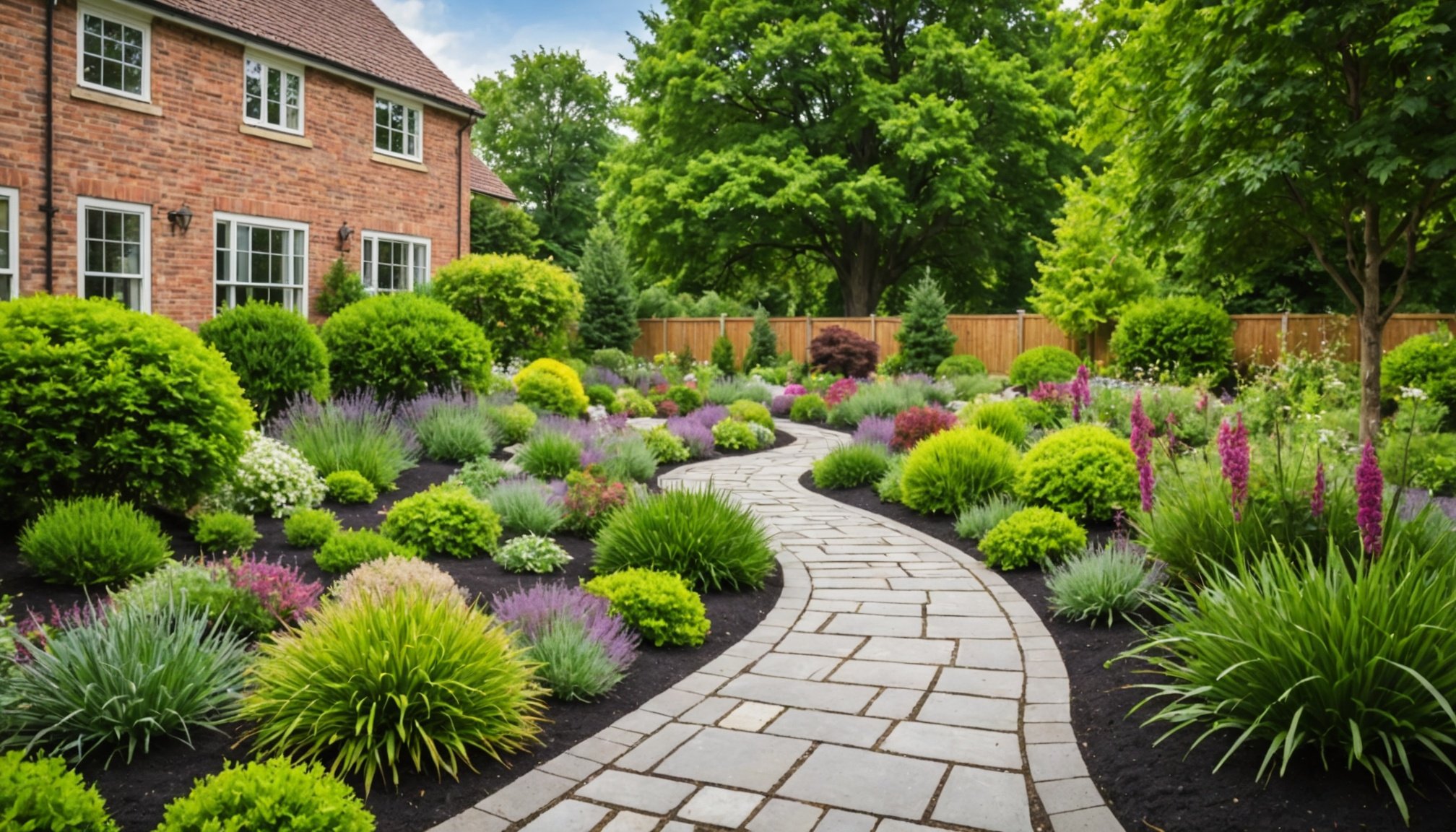Overview of Sustainable Landscaping
Sustainable landscaping is an approach that integrates eco-friendly practices into the cultivation and maintenance of gardens and lawns. This method focuses on preserving natural resources and fostering environmental health. It encompasses the use of native plants, efficient water management, and minimal chemical applications. The importance of sustainable landscaping lies in its ability to create landscapes that are not only aesthetically pleasing but also beneficial to the ecosystem.
Eco-friendly practices in landscaping result in numerous advantages for homeowners and the environment. Firstly, it reduces water consumption through drought-resistant plant selection and advanced irrigation systems. Secondly, it supports biodiversity by providing habitats for local wildlife and pollinators, thereby enhancing the ecosystem’s resilience.
Also to read : Top Financing Strategies for New Property Investors in the UK: Unlocking Your Investment Potential
Homeowners can also experience financial benefits through sustainable landscaping. Properties that adopt sustainable practices tend to stand out in the real estate market, as buyers increasingly value environmentally responsible features. This preference often leads to property value enhancement, offering a return on investment for those who invest in eco-friendly landscaping.
Ultimately, by adopting sustainable landscaping practices, homeowners can contribute to a healthier environment while potentially increasing the value of their property. This alignment of ecological and economic benefits makes sustainable landscaping an attractive choice for modern gardeners.
Also to read : Top Strategies for Maximizing Energy Efficiency in UK Home Renovations
Choosing Native Plants for the UK
Incorporating native plants into your garden is a wise choice for enhancing local biodiversity and creating a low maintenance gardening experience. Native plants are those that have evolved naturally in a region, developing unique associations with local wildlife. This symbiotic relationship fosters greater resilience against pests and environmental stressors.
Advantages for Local Ecosystems
Adopting native plant species in your garden is essential for promoting biodiversity. These plants support local wildlife, including birds, bees, and other pollinators, which depend on them for food and shelter. By maintaining a balance in the ecosystem, native plants contribute to the health and sustainability of your garden.
Examples Suited for UK Climates
The UK climate supports a range of native plants, such as the Common Hawthorn, English Bluebell, and Wild Marjoram. These species are well adapted to local soil and weather patterns. Consequently, they require less water and fertiliser, reducing the need for intensive care and making them a perfect fit for low maintenance gardening.
Tips for Incorporating Native Plants
When introducing native plants to your landscape, consider grouping species that share similar light and water requirements. This practice ensures they thrive together, creating a self-sustaining ecosystem. Additionally, integrating native plants with existing non-native species can further enrich the visual and ecological diversity of your garden.
Water Management Strategies
Incorporating rain gardens into your landscaping can significantly enhance your property’s value by providing a sustainable solution for managing stormwater. These gardens are strategically designed to absorb and filter rainwater, helping prevent flooding and erosion while supporting diverse plant life. By choosing native plants, rain gardens can be low-maintenance and environmentally friendly, contributing positively to the ecosystem.
Following the concept of rain gardens, permeable paving offers another innovative approach for water management. Unlike traditional surfaces, which merely redirect rainwater, permeable paving allows water to seep into the ground, reducing runoff and recharging groundwater supplies. This technique supports water conservation by facilitating natural filtration processes and is often utilised in driveways, walkways, and patios.
For efficient water usage in gardens, several strategies can be employed. Implementing drip irrigation systems is a precise method that delivers water directly to plant roots, minimising evaporation and excess use. Mulching can help retain soil moisture, reducing the need for frequent watering. Collecting rainwater in barrels is another effective technique, supplementing garden irrigation and conserving municipal water resources.
Collectively, these water management strategies not only bolster sustainability but also offer practical solutions to everyday landscaping challenges. They balance aesthetic value with environmental responsibility.
Enhancing Outdoor Spaces with Hardscaping
Transforming your outdoor living spaces with hardscaping can significantly enhance your property aesthetics. Hardscaping is the incorporation of non-living elements into landscaping, such as patios, walkways, and walls. It brings structure and functionality, creating areas where people can gather and enjoy nature comfortably.
A key aspect of effective hardscaping is balancing these elements with sustainable landscaping. Using eco-friendly materials like permeable pavers can complement the natural environment and reduce water runoff. This conscious choice not only maintains ecological integrity but also adds a contemporary flair to your outdoor spaces.
To increase the appeal of your outdoors, consider integrating key hardscaping elements that resonate with your aesthetic preferences. For instance, a stone patio paired with a fire pit can become the focal point of your backyard. Meanwhile, pathways made of natural stone or bricks can guide guests from one area to another, making the entire space feel larger and more connected.
Achieving a cohesive design involves balancing hardscaping with softscaping, which includes plants and grass. Strategically placing trees and shrubs alongside your hardscape structures can soften the look and create a seamless transition. Remember, the goal is to create inviting, practical spaces that enhance your lifestyle while elevating the overall beauty of your property.
Incorporating Renewable Energy Solutions
Embracing solar energy in your landscape design comes with a spectrum of advantages, most notably sustainability and reduced energy costs. Integrating solar lighting transforms garden aesthetics and functionality, providing illumination without additional electricity expenses. These solutions capture sunlight during the day to power lights at night, offering an eco-friendly option to traditional lighting systems.
Consider adopting energy-efficient landscaping techniques, such as planting shade trees to naturally cool buildings, which can significantly reduce the need for air conditioning. Additionally, using native plants can minimise water use and integrate with local ecosystems, enhancing sustainability by conserving natural resources.
There are numerous incentives available that support renewable energy installations, often varying by location. For instance, some regions offer tax credits or rebates for installing solar panels or energy-efficient systems. These financial aids aim to offset initial setup costs, making solar energy solutions more accessible to homeowners.
When planning your landscape, exploring incentives, and weighing the costs against benefits, can reveal substantial long-term savings. By implementing solar energy and efficient landscaping methods, you not only contribute positively to the environment but also gain economic advantages.
Financial Benefits and Incentives
Investing in sustainable landscaping not only benefits the environment but also offers significant financial gains. Initial cost savings are evident through reduced expenses in energy, water, and maintenance. Efficiency in water use, for instance, lowers bills by minimising waste. Sustainable practices also typically demand fewer resources in the long term, resulting in continued savings.
In terms of property value increase, eco-friendly landscaping plays a crucial role. Properties with thoughtfully designed landscapes can see their market value rise. Potential buyers are often attracted to homes showcasing sustainability, leading to a more competitive market standing.
Moreover, several programs and financial incentives exist to encourage sustainable practices. Governments frequently offer grants and programs to support eco-friendly landscaping improvements. These initiatives can cover various aspects, from water-efficient irrigation systems to non-toxic pest management, effectively reducing the upfront costs of these implementations.
Understanding the available incentives and aligning them with sustainable practices can enhance your landscape’s eco-friendly appeal, boosting both aesthetic and market value. Leveraging such grants and programs allows homeowners to contribute to environmental preservation while enjoying tangible financial benefits. This comprehensive approach ensures a rewarding investment in both immediate and long-term scenarios.
Case Studies and Real-Life Examples
Embarking on successful landscaping projects can significantly enhance property value and sustainability. Across the UK, numerous case studies shed light on how homeowners have transformed their outdoor spaces. These projects not only beautify homes but also contribute to ecological balance.
One remarkable example is a Northampton homeowner who converted a traditional lawn into a dynamic wildflower meadow. This project became a haven for local pollinators while reducing maintenance and water usage. The increase in property value was evident, with buyers appreciating the cost-saving and eco-friendly features. Another case in Manchester saw an urban garden transformed with vertical gardens and rainwater harvesting systems. These innovations improved the aesthetic appeal and sustainability quotient of the property leading to a notable rise in market price.
Key lessons from these homeowners’ experiences emphasize the importance of planning and investment. Selecting native plants ensures resilience and reduces long-term care efforts. Homeowners also noted that incorporating sustainable elements like permeable paving or rain gardens can add value and appeal.
By learning from these successful landscaping projects, UK homeowners can implement changes that not only enhance their living environment but also provide a promising return on investment.
Local Climate Considerations in Landscaping
Understanding the UK climate is vital for successful landscaping. The United Kingdom is home to several distinct climate zones, each presenting unique environmental considerations for gardeners. These zones are primarily defined by variations in temperature, rainfall, and wind patterns.
In northern regions like Scotland, expect cooler temperatures and higher rainfall, which necessitates choosing hardy plants that thrive in wet conditions. Conversely, southern areas like Cornwall enjoy milder weather, allowing for a diverse range of plant choices.
Regional landscaping involves adapting your garden to its specific climate zone. For example, utilizing plants that are native to your area can ensure better growth and longevity. Consider drought-resistant varieties in drier regions or moisture-loving varieties in rainier areas.
Effective landscaping in the UK requires not just plant selection, but also strategic garden design to accommodate local weather patterns. Raised beds can improve drainage in wet areas, while windbreaks may be necessary in windy locales.
Moreover, knowing your local climate impacts garden maintenance. Seasonal care, such as mulching to protect roots from frost or implementing efficient watering systems during dry spells, can mitigate climate-related challenges. Embrace each region’s characteristics to create resilient and beautiful landscapes.











